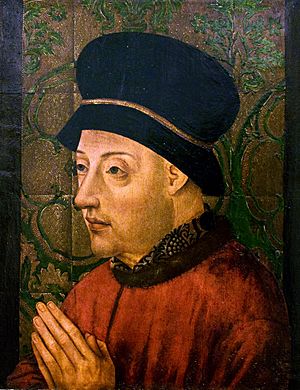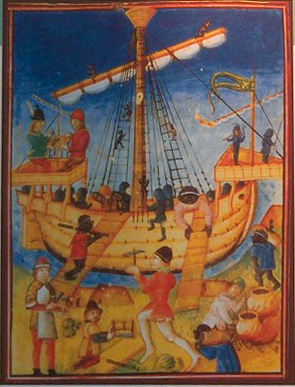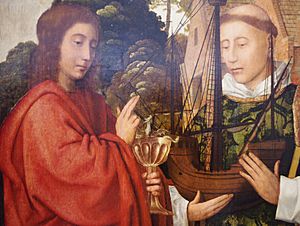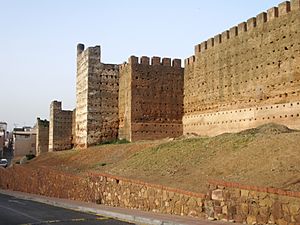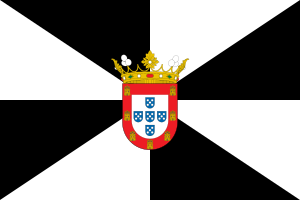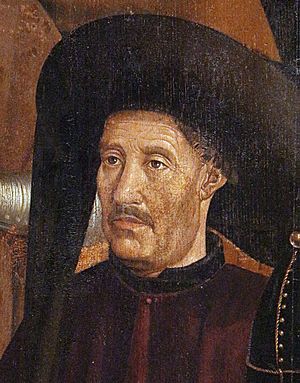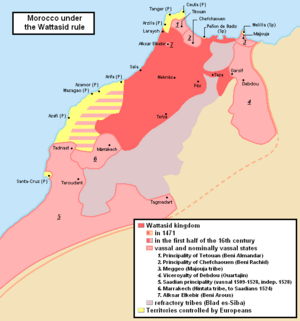Portuguese conquest of Ceuta facts for kids
Quick facts for kids Portuguese Conquest of Ceuta |
|||||||
|---|---|---|---|---|---|---|---|
 Panel of azulejos by Jorge Colaço (1864–1942) at the São Bento railway station, depicting Prince Henry the Navigator during the conquest of Ceuta |
|||||||
|
|||||||
| Belligerents | |||||||
| Marinid dynasty | |||||||
| Commanders and leaders | |||||||
|
Governor Salah Ben Salah | ||||||
| Strength | |||||||
|
45,000 or 50,000 men, including:
About 200 ships:
|
Unknown | ||||||
| Casualties and losses | |||||||
| 8 men † | Several thousands killed or taken prisoners 1 cannon captured |
||||||
The Portuguese conquest of Ceuta happened on August 21, 1415. It was a battle between the forces of King John I of Portugal and the Marinid kingdom of Morocco. The city was captured by Portugal after a well-planned attack. This victory marked the start of the Portuguese Empire.
Contents
Why Ceuta Was Important
Ceuta is a city on the coast of North Africa. It is located right on the Strait of Gibraltar. This strait is a narrow waterway that connects the Atlantic Ocean to the Mediterranean Sea. This made Ceuta a very important place for trade and control of the seas.
Ceuta's History and Trade
Ceuta has a long history. It was used as a starting point for the Arab conquest of Spain in 711. Over the centuries, many different groups ruled the city. These included the Almoravids and the Almohads.
The city was a busy trading hub. It traded with places like Egypt and Libya. Ceuta was also known for its tuna fishing and coral exports. However, it was also a place where pirates would sell stolen goods. Controlling Ceuta meant Portugal could control a major route for gold from Africa. It also helped Portugal against its rival, Castile.
Portugal's Plans for Ceuta
After winning a battle against Castile in 1385, King John I of Portugal signed a peace treaty in 1411. Even before this peace, King John I had his eyes on Ceuta. He started planning to take the city as early as 1409.
The King's sons, Prince Duarte, Prince Peter, and Prince Henry (later known as 'the Navigator'), were very excited about the idea. They saw taking Ceuta as a chance to gain wealth and fame.
Getting Ready for the Attack
Preparations for the attack on Ceuta began years before the actual event. The goal was kept a secret. No new taxes were raised, as this would have revealed the plan. Instead, the kingdom took out loans and hired foreign ships. Old ships were fixed, and new ones were built. About 200 ships were made ready.
Princes Help with Recruitment
Prince Henry was in charge of finding men from the northern parts of Portugal. His brother, Prince Peter, gathered men from the southern areas. Prince-heir Duarte handled the paperwork.
Secret Scouting Mission
To learn about Ceuta's defenses, King John sent a fake embassy to Sicily. The ambassador, Dom Álvaro Gonçalves Camelo, was told to stop in Ceuta for supplies. While there, he secretly measured the depth of the harbor. After returning to Portugal, he drew a map of Ceuta for the King and his sons using sand and thread. This gave them important information.
Sharing the Plan
Only after getting this secret information did King John tell his wife, Queen Philippa. Later, he told his trusted general, Dom Nuno Álvares Pereira, who fully supported the plan. Finally, the King shared the plan with his top advisors. Everyone agreed to the expedition.
A Clever Trick to Hide the Goal
People in Portugal and other countries wondered what King John was planning. Some thought he would go on a Crusade. Others guessed he would attack Ceuta. To keep the real target a secret, King John sent a fake ambassador to Holland. The ambassador pretended to demand money for supposed wrongs against Portuguese sailors. This made people think Portugal was going to attack Holland.
Final Gathering in Lisbon
In the spring of 1415, a plague hit Lisbon. The royal family had to move. On July 10, Prince Henry arrived in Lisbon with many ships and well-trained men. The Portuguese fleet had about 200 ships and up to 50,000 men. This included soldiers from England, France, and Germany.
Many important people joined the expedition. These included the King's sons, famous generals, and leaders from noble families.
Queen Philippa's Last Wish
Just before the fleet left, Queen Philippa became very ill with the plague. She called her sons to her side to give them her blessing. She gave her three oldest sons swords for their knighthoods. She also gave them pieces of the True Cross, telling them to keep their faith strong.
The King was very sad about his wife's illness. She died peacefully, saying the north wind was good for her husband and sons' voyage to Africa. The expedition was almost called off, but King John decided to continue.
On July 23, King John boarded his royal ship. Two days later, the entire fleet left Lisbon. People watched from the hills and beaches as the ships sailed away.
The Journey to Ceuta
The Portuguese fleet sailed south from the Tagus River. They went around Cape St. Vincent on July 26 and anchored at Lagos.
At Lagos
In Lagos, the King went ashore for Sunday mass. The royal chaplain read a special message from the Pope. This message supported the attack on Ceuta.
Stopping at Faro and Tarifa
On July 30, the fleet sailed to Faro. They stayed there until August 7 because of weak winds. That night, they entered the Strait of Gibraltar and anchored near the Spanish town of Tarifa. Many in the fleet still thought they were going to attack Sicily.
At Tarifa, the local governor offered supplies, but King John refused. The governor was upset, so he slaughtered the animals and left them on the beach. The King and princes gave him jewels and money to make up for it.
Unexpected Delay
From Tarifa, the fleet went to Algeciras. King John ordered the attack on Ceuta for August 12. But strong winds blew the large Portuguese ships off course, almost to Málaga. Only the smaller oarships made it to Ceuta's harbor.
The Attack on Ceuta
When the Portuguese ships arrived, the governor of Ceuta, Salah ben Salah, sent many women and children away. He was joined by local tribesmen and religious leaders. The Portuguese later claimed that 100,000 people came to defend Ceuta. However, the Sultan of Fez did not send any help.
The first fights began. The Portuguese ships were shot at from the city walls. The admiral's ship was hit the worst. Despite the fleet being separated, the admiral sent some men ashore to fight.
On August 16, King John gathered his fleet in front of Ceuta. He planned to attack the next day. But strong winds scattered the fleet again. The King had to take shelter in Algeciras with the oarships.
Thinking the attack was off, many of Ceuta's defenders left. Governor Salah ben Salah also sent away the remaining volunteers. This left only the regular soldiers to defend the city.
A New Plan
From Algeciras, Prince Henry was told to bring back all the scattered ships. A plague broke out among the crews. King John held a meeting with his commanders. He refused to call off the attack. On the night of August 20, the Portuguese fleet sailed again. They anchored in Ceuta's harbor, ready to land the next day.
Salah Ben Salah ordered many lights to be lit on the walls. He wanted to make the city look strong and well-defended. But this trick did not fool the Portuguese.
The Final Assault
On the morning of August 21, 1415, King John I ordered his troops to land and attack the city. As the King was getting into a small boat, he was wounded in the leg. Prince Henry was then signaled to lead the troops ashore.
Prince Henry was the first prince to land with his men. His brother, Prince Edward, followed him. With about 300 men, they pushed the Muslim defenders back to the Almedina gate. The Portuguese broke through the gate before it could be fully closed.
The Moroccans fought back in the narrow streets. A very large man from Nubia or Sudan threw big stones. But after he was killed, the Muslims ran away. Prince Pedro, Prince Henry, and the Constable chased them deeper into the city.
As the Portuguese entered, Salah ben Salah came down from the citadel. He tried to stop the attackers so people could escape with their families. Meanwhile, another group of Portuguese tried to open a different gate but were pushed back.
Prince Henry left some men to guard the gate while they waited for the rest of the army. The King, Prince Pedro, and the Constable arrived shortly after. King John did not fight further, staying by the gate. During the fighting, a rumor spread that Prince Henry had died. King John supposedly said, "such is the end which soldiers must expect."
Salah ben Salah held the citadel until sunset. But seeing no way to win, he fled the city with his men and their families. The next morning, August 21, the Portuguese found the citadel empty. Ceuta was completely in Portuguese hands. Most of Ceuta's people had fled, but some were killed, and others, like women, children, and the elderly, were found in their homes.
Álvaro Vaz de Almada, 1st Count of Avranches raised the flag of Lisbon over Ceuta castle. This flag is still used today as the flag of Ceuta, with the Kingdom of Portugal's coat of arms added to it.
Prince Henry, later known as 'the Navigator', showed great bravery in the battle. He was wounded during the conquest.
After the Conquest
On August 21, the Portuguese turned the main mosque into a cathedral. They found two church bells in its tower. These bells had been stolen by pirates from a Portuguese church in Lagos. Ceuta became a diocese, and an English priest was made its first bishop.
The city was looted, but it was not as profitable as King John had hoped. The Count of Barcelos took many marble columns and a fancy vaulted roof for his home in Portugal.
King John sent messages to other European leaders about his victory. He invited the King of Aragon to join him in conquering more lands in North Africa.
King John decided to keep Ceuta, even though some of his men disagreed. He wanted to use it for future plans in the area.
Choosing a Governor
Finding a governor for Ceuta was hard. Many high-ranking nobles did not want the dangerous job. But Dom Pedro de Meneses volunteered. His father had fought against King John in a civil war, which might explain why Dom Pedro was so eager for this honor.
The King ordered almost 3,000 men to stay in Ceuta as a garrison. Many common soldiers did not want to stay in an isolated city surrounded by enemies. They tried to bribe officials or pretended to be sick to go home. However, some craftsmen and nobles chose to stay, hoping for wealth and glory.
Ceuta's Later Years
After the Portuguese fleet left, the people of Ceuta who had fled tried many times to take back the city. But the Portuguese soldiers easily fought them off. Dom Pedro had houses and orchards around the city pulled down to improve visibility and prevent ambushes.
A special office called the Casa de Ceuta was set up in Portugal. It was in charge of supplying the city.
In 1419, the Marinid Sultan of Morocco, with help from the Emir of Granada, tried to take back Ceuta. But the Portuguese, led by Dom Pedro de Meneses, successfully defended the city. The Sultan was later killed, and Morocco fell into chaos. This gave Ceuta a few years of peace.
Ceuta became a strong military base. It was a main place for Christian ships to raid Muslim shipping in the western Mediterranean. This brought profits to the captain of Ceuta and King John I. It also made sailing in the Strait of Gibraltar safer for Christians. Many soldiers from different countries came to Ceuta looking for wealth and glory.
Prince Henry became famous for his bravery at Ceuta. Leaders from England, the Pope, and the Holy Roman Emperor offered him command of their armies. But Henry turned down these offers.
Under King John's son, Duarte, Ceuta became expensive to keep. Trade routes changed, and caravans went to Tangier instead. It became clear that without Tangier, Ceuta was not as valuable.
In 1437, Prince Henry and his brother Ferdinand convinced King Edward to attack Tangier. This attack failed badly. In a treaty, Henry gave his brother Ferdinand as a hostage to the Moroccans. He also promised to give Ceuta back to them.
Controlling Ceuta led Portugal to explore and expand further. Portugal focused on the coast of Morocco for resources like grain, cattle, sugar, and textiles.
Ceuta stood alone for 43 years. Its position was made stronger when Portugal took Ksar es-Seghir in 1458, and Arzila and Tangier in 1471.
The Treaty of Alcáçovas (1479) and the Treaty of Tordesilhas (1494) officially recognized Ceuta as a Portuguese possession.
See also
 In Spanish: Batalla de Ceuta (1415) para niños
In Spanish: Batalla de Ceuta (1415) para niños
- Tripas à moda do Porto
- Battle of Tangier (1437)
- Portuguese conquest of Ksar es-Seghir
- Anfa expedition (1468)
- Conquest of Asilah
- Portuguese Asilah
- Portuguese Tangier
- Illustrious Generation
- Aviz Dynasty
- Moroccan-Portuguese conflicts
- Portuguese Discoveries


